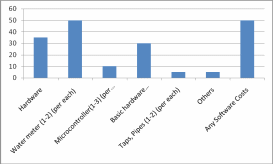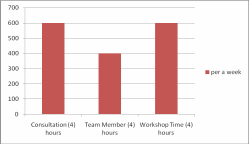Introduction
To begin with, it is necessary to mention that Australia is regarded as the second driest continent on the planet, apart from the Antarctic. One of the most essential challenges that are faced by the inhabitants of Australia is water consumption and conservation. This report is aimed to make up the budget of this project, incorporating real and virtual expenses, required for the proper adjustment of the compound and multi-structured monitoring system.
Number-off and Program Delivery
The fact is that the various number-offs essentially impact the method, and hence unit cost, of manufacture. Originally, the number offs may be different, and may be caused by various factors, nevertheless, any number off should impact the final cost of the project, consequently, they should be taken into account while planning the budget. Nevertheless, if these problems are of financial or technical origin, it should be stated that there is a strong necessity to get ensured against them by financing the whole project at once and ordering the necessary number of technical appliances before the implementation process.
Originally, the customer may be involved in the investment process at any phase of the project delivery. Nevertheless, the project aims to get the revenue, consequently, the customer will be justified in investing in special tools only after the project will be delivered and properly adjusted, thus, the customer will be able to expand the monitoring system, and employ and train the maintenance staff. As for the spare holding policy, the customer may be enabled to consume them for the initial maintenance and trouble fixing.
Price
The price of the project entails two categories of costs: real costs and virtual costs. Originally, the real costs entail the costs of all the components, required for the performance of the technical part of the project. This

The total price is $185. 8% of the contingency will add $14 to the total cost.
The data of the costs are included in the following table
Taking into account that there is $185 total, it should be stated that the rest of $70 is allocated for the hardware (including basic hardware) and other expenses..
The virtual costs
Mentor salary: $1800
$100 per hour in 24 weeks.
Workers salary:
Each team member is working 4 hours per week
Each team member is given $100 per hour
the team has 9 members.
Work duration is 24 weeks


Thus, the selling price will be $9600 + $185 + $14 + 15% = $55428,85
Quantitative Analysis
In order to start making up the budget, it will be necessary to have some quantitative and qualitative analyses. Originally, according to Eckstein (2003) there are several basic cash inflows (revenues) and cash outflows (costs) in the life cycle of a successful new product. Cash inflows come from product sales. Cash outflows include spending on product and process development; costs of production ramp-up such as equipment purchases and tooling; costs of marketing and supporting the product; and ongoing production costs such as raw materials, components, and labor. From the financial point of view, it is necessary to mention that successful or at least potentially successful projects generate more cumulative inflows than similar outflows. The measure of defining the size of the inflow or an outflow is the Net Presented Value (NPV) of the project, which is also regarded as the relation of the current price towards the expected cash flows. The quantitative analysis of the project represented by Inventioneers Company should estimate the NPV of a project’s expected cash flows, as there is a strong necessity to incorporate restricted virtual expenses. From this point of view, the budget should be divided into three phases:
- Consultation and design.
- Implementation.
- Testing.
Originally, the quantitative part of this analysis presupposes the making up of the budget with taking into account the limitations of the expenses allocated for the consultation works (this also entails design and testing), consequently, the main emphasis should be placed on the implementation phase.
Project Scope
The details of cash flows should be precisely estimated and are required to be coarse enough. It is necessary to emphasize that the most general categories of cash flow for a typical new product development project are:
- Development cost (all remaining design, testing, and refinement costs up to production ramp-up).
- Ramp-up cost.
- Marketing and support cost.
- Production cost.
- Sales revenues.
The fact is the levels of detailing the project generally depend on the categories of decisions, which are supported by the models, greater. More detailed modeling, in its turn, may reflect on the five cash flow processes, or it may take into account some other flows. Typical modifications of the detail levels (according to Ulrich and Eppinger, 2008) are the following:
- Breakdown of the costs into direct expenses and indirect prices (i.e., overhead).
- Breakdown of marketing and support expenses into promotion costs, direct sales costs, and service costs.
- Taking into account the tax effects, entailing the depreciation and investment tax credits. (Tax effects are generally considered in simpler financial modeling)
- Incorporation of such various inflows and outflows as working capital prerequisites, and the impact of the innovative product on existing product sales, as well as salvage costs, with the opportunity expenses.
Estimations
The total cost for team member hours will be less than it is initially estimated.
Costing points:
- Team member time (1 hour = AUD $100)
- Consultation time (1 hour = AUD $150)
- Workshop time (1 hour = AUD $150)
- Workshop and consultation time is limited to a total of $1800.
It is thought that whether every member in the group works 8 hours per week, then each member will work 208 hours on the project.
The time frames of the project implementation are helpful for the definition of the number of hours, during which the consultants and workers will be engaged in performing the project requirements.
Conclusion
Finally, it is necessary to emphasize that one of the most essential and significant steps in the perfect decision-making process is the presence of reliable data and information, which is regarded as the solid basis of the decisions. Though the projected system will not inherently save any water and will not restrict water consumption, it will permit the residents to monitor their water consumption levels. Still, the full use of the system may be revealed if propaganda works are held, for people realized the seriousness of the problem. It is expected, that this system could be implemented in most households, and with a low price and easy set-up, eventually in all sorts of industry, office and commercial environments. The possibility for expansion is as diverse as the situations in which the system could be useful, and the developers of this project believe this can be a great achievement in the sphere of water-saving and conservation for the sake of the environment.
References
Eckstein, Otto. Water-Resource Development: The Economics of Project Evaluation. Cambridge, MA: Harvard University Press, 2003.
Lee, Richard. “Managing a Technology Staff Development Project.” T H E Journal (Technological Horizons In Education) 18.9 (2005): 71.
Reeder, Kevin. “Quick Projects Run Fast and Encourage Speedy Decisions: The Phases of the Project Need to Be Complete, and Designers Need to Have an Understanding and Empathy for Their User Regardless of the Project Budget or Schedule.” The Technology Teacher 65.6 (2006): 16.
Ulrich, K. T., Eppinger, S. D. Product Design and Development. 4th Edition, Irwin McGraw-Hill. 2008.